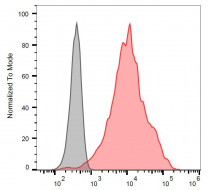ARG62922
anti-CD71 / Transferrin Receptor antibody [MEM-189]
anti-CD71 / Transferrin Receptor antibody [MEM-189] for Flow cytometry,Immunoprecipitation,Western blot and Human
Cancer antibody; Cell Biology and Cellular Response antibody; Developmental Biology antibody; Immune System antibody; Metabolism antibody
Overview
| Product Description | Mouse Monoclonal antibody [MEM-189] recognizes CD71 / Transferrin Receptor |
|---|---|
| Tested Reactivity | Hu |
| Tested Application | FACS, IP, WB |
| Specificity | The clone MEM-189 reacts with CD71 antigen (transferrin receptor), a 95 kDa type II homodimeric transmembrane glycoprotein expressed on activated B and lymphocytes, macrophages and erythroid precursors; it is lost on resting blood leukocytes. MEM-189 does not block binding of transferrin to the receptor. HLDA VI; WS Code NL N-L025 |
| Host | Mouse |
| Clonality | Monoclonal |
| Clone | MEM-189 |
| Isotype | IgG1 |
| Target Name | CD71 / Transferrin Receptor |
| Antigen Species | Human |
| Immunogen | KG1 human acute myelogenous leukaemia cell line |
| Conjugation | Un-conjugated |
| Alternate Names | TFR1; CD antigen CD71; CD71; T9; p90; TR; Trfr; Transferrin receptor protein 1; TRFR; sTfR; TfR1; TfR; TFR |
Application Instructions
| Application Suggestion |
|
||||||||
|---|---|---|---|---|---|---|---|---|---|
| Application Note | WB: Under non-reducing condition. * The dilutions indicate recommended starting dilutions and the optimal dilutions or concentrations should be determined by the scientist. |
Properties
| Form | Liquid |
|---|---|
| Purification | Purified from ascites by protein-A affinity chromatography. |
| Purity | > 95% (by SDS-PAGE) |
| Buffer | TBS (pH 8.0) and 15 mM Sodium azide |
| Preservative | 15 mM Sodium azide |
| Concentration | 1 mg/ml |
| Storage Instruction | For continuous use, store undiluted antibody at 2-8°C for up to a week. For long-term storage, aliquot and store at -20°C or below. Storage in frost free freezers is not recommended. Avoid repeated freeze/thaw cycles. Suggest spin the vial prior to opening. The antibody solution should be gently mixed before use. |
| Note | For laboratory research only, not for drug, diagnostic or other use. |
Bioinformation
| Database Links | |
|---|---|
| Gene Symbol | TFRC |
| Gene Full Name | transferrin receptor |
| Background | CD71 (transferrin receptor) is a type II transmembrane glycoprotein expressed as homodimer in erythroid blood cell line and in activated leukocytes. Upon binding of holotransferrin (complex of transferrin and iron ions), CD71 is internalized by clathrin-mediated endocytosis. Acidification of endosomes by vesicular membrane proton pumps leads to dissociation of iron ions, whereas transferrin (apotransferrin) remains associated with CD71 and recycles to the cell surface, where it is released upon exposure to normal pH. CD71 is also involved in uptake of non-transferrin bound iron. |
| Function | Cellular uptake of iron occurs via receptor-mediated endocytosis of ligand-occupied transferrin receptor into specialized endosomes. Endosomal acidification leads to iron release. The apotransferrin-receptor complex is then recycled to the cell surface with a return to neutral pH and the concomitant loss of affinity of apotransferrin for its receptor. Transferrin receptor is necessary for development of erythrocytes and the nervous system (By similarity). A second ligand, the heditary hemochromatosis protein HFE, competes for binding with transferrin for an overlapping C-terminal binding site. [UniProt] |
| Research Area | Cancer antibody; Cell Biology and Cellular Response antibody; Developmental Biology antibody; Immune System antibody; Metabolism antibody |
| Calculated MW | 85 kDa |
| PTM | N- and O-glycosylated, phosphorylated and palmitoylated. The serum form is only glycosylated. Proteolytically cleaved on Arg-100 to produce the soluble serum form (sTfR). Palmitoylated on both Cys-62 and Cys-67. Cys-62 seems to be the major site of palmitoylation. |
Images (1) Click the Picture to Zoom In
-
ARG62922 anti-CD71 / Transferrin Receptor antibody [MEM-189] FACS image
Flow Cytometry: Separation of stained K562 cells (red) from unstained K562 cells (grey). Cells were stained with ARG62922 anti-CD71 / Transferrin Receptor antibody [MEM-189] at 4 µg/ml dilution, followed by APC-conjugated Goat anti-Mouse antibody.
Clone References








